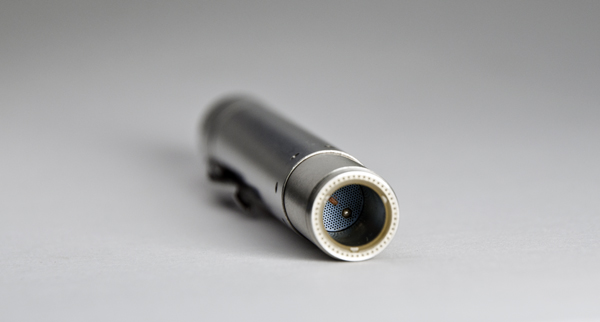There are many differences between different age units, looking into the battery chamber or the herb chamber will reveal some of these. The herb chamber began with a blue heater shield with exposed sensor, this is the era of the cop lights and high failure rate.
This 3rd party heater assembly iterated until it was a white shield, with updated sensor, and with an extra mesh screen placed on top of the heater shield. The yield was questionable, some worked amazingly, many crapped out.
I guess ‘V5’ is really a reference to in-house printed heater assemblies. These front body assemblies are what most will get back from RMA and (apart from this recent fire) is what everyone has been waiting on, as production has been limited by HL acquiring and learning the laser sintering manufacturing tech. ‘V5’ or some modern variant is basically what new units will ship with. These have a white (ceramic?) heater shield and no exposed sensor component, and again are covered with the SS laser cut and scratch-proof screen seen in the base of the herb chamber. I haven’t had one of these HL heaters fail on me, for the record. In 2017 the 3rd party heaters were commonly failing after 0-3 weeks of heavy or even light use, and they often ran cold or gave up mid toke. This is largely the cause of the varied user experience. I’m fast approaching 2 years out of my first HL heater with very consistent foolproof usage. I’ve clocked up 10 months on two others, one is lent to someone who has a unit stuck at HL, they went to confirm their return address for a 2018 RMA the day of the fire notice! He said the one on lend is still pumping out clouds. I have no use for so many working units, two is a good number however. And with them, I have no use for any other portable and I’ll be downsizing my collection soon I think. Things should be used and have use.
Anyway, with the hopper, the complexity of the back end and the number of contacts where high current is pushed is the cause of other performance idiosyncrasies such as back-end heat, stuttering LEDs or other continuity issues. Keep the exposed contacts clean and batteries charged to maintain performance. I rarely need to clean PFEs, overall this is so simple to maintain.
My latest unit, bought at a whopping 35% off during 4/20 sales 2018, has an updated PCB with quality components (dual crystals, quality caps and a mosfet exposed). My RMA units are patch fixed and still retain older aspects of the design which doesn’t really impact anything, it just takes a couple of clicks to power it up after it auto shuts down. The latest back-end has improved circuitry too. The two crystals on the heater assemblies PCB stand out as they have reflective/shiny metallic packages compared to the older style, sometimes hand built and eventually CNC pick and placed boards. The solder screening is a typical green, so other than the components and schematics it all looks pretty tiny and similar, but lots has changed, test points introduced (one then two) other things added, removed, moved and tweaked. Quite sure no wave soldering is used in production, this is a through hole component soldering method and it seems like HL only has TH parts in the heater assembly, on Instagram they show a matrix of assemblies that are CNC automagically soldered.
Basically things have massively improved on the electrical design over the years, the design and BOM are better and with the added automation so is the QA. You can see how the first units were hand baked under a hot air gun on-top of a burnt bit of wood in the video recently linked here profiling HL in their old workshop from the indiegogo days. People often chirp up about how nothing has changed with HL, but they are patently wrong. There has been leaps and bounds of incremental improvement that adds together and transforms this product. I’ve said before that the difference between my backer unit and my 2018 retail release was a big one, and it was nice to read someone else appreciate this
@J.D.420. It is genuinely amazing. For their first wave of design I’ve always considered this as the ‘iPod’ standard of vape design. Apple had a huge team (two competing actually), Foxconn and a shit tonne of cash to get that right from the get go, and made the smart move of keeping R1 from international sales as they did with the iPhone. FireWire and a mechanical scroll wheel, the design elements changed a bit, but the functionality was consistent. HL didn’t have a Newton to learn from, they’ve gone straight in with the functionality and golden design standards. They’ve brought the buttons onto the now capacitive scroll wheel, and then they catch fire. Unlike the iPod, which now that mobile computing has taken over, it makes sense to neglect a dedicated device, a vaporiser is staple. I don’t want to vape from my phone or next gen VR glasses. Vaping makes the cloud and it can’t be a cloud like music streaming. It’s taking time, but there are too few alternatives that vaporise as I want and many examples of the antithesis
The external design hasn’t changed all too much with the Grasshopper, but the very early units had some mechanical differences to the back-end. After laser welding was obtained the SS section of the Ti hopper (under the dial and connecting the clip) changed to a solid ring design which is much stronger and is still the current design.
the OG design was flawed in several ways.
Eventually a brand new Hopper will be the safe bet that everyone needs. But because it’s modular with a generous warranty, existing units should become that to the same extent. The only thing that would really change this Grasshopper conundrum is if someone like a Google or Samesung come along and rip it off, but it won’t happen in today’s climate. And as for a dedicated music player, the DAC in an iPod touch outclasses anything in-device from anyone but LG. The GH will still be vapor bonging at my house and national parks!
The Tinymight could be the next best thing, but the Hopper Labs heater is special and vapophiles will tell. The eventually thing is definitely dragging on, but so is the release of anything else good.







